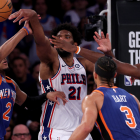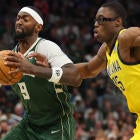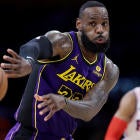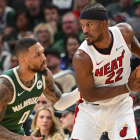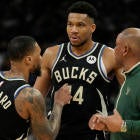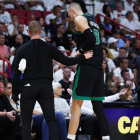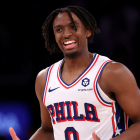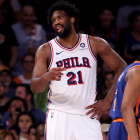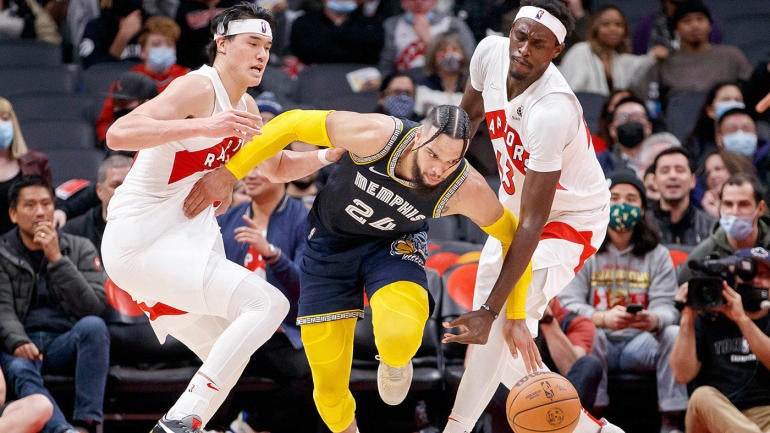
When I interviewed Charlotte Hornets coach James Borrego for an early-season story, he threw out a statistic: If you "win the rebounding game and the turnover game," you have about an 80-percent chance of victory. "Check me on that," he added.
I did, and Borrego was on the money: In the 2020-21 regular season, teams that both outrebounded and committed fewer turnovers than their opponents went 325-71, which is an 82-percent winning percentage.
(Note for numbers nerds: I used total rebounds and turnovers for the above. If you instead use turnover percentage and offensive rebounding percentage -- two of the "four factors" -- then the winning percentage was 65 percent last season.)
Last year's Hornets had the fifth-highest turnover percentage in the NBA, per Cleaning The Glass, and they were almost as bad when it came to defensive rebounding. When Borrego said in that same interview that "the possession game is huge" and he'd never spent so much time drilling defensive rebounding, it sounded like he was some sort of old-school taskmaster.
His freewheeling Hornets, though, are anything but behind the times. Borrego's philosophy is that, in order to maximize the 24-second shot clock, you must get into your offense as quickly as possible and never give the defense an opportunity to relax. He wants Charlotte to run off made shots. He doesn't believe that any of this is incompatible with winning the possession game.
Borrego is not the only forward-thinking coach who sees it that way. "The possession game" used to connote a slow, conservative, grimy style of play, but the teams that play it today are fast, fun and futuristic.
Nick Nurse said in early November that the Toronto Raptors want to take at least five more shots than their opponents every game. "Most of the analytics say that once we get to that number the chances of winning improve greatly," he told reporters, unaware that, about 90 percent of the way through the season, Toronto would be averaging 6.9 more field goal attempts than its opponents. (All stats in this story are through games played on March 28.)
The only other team to accomplish Nurse's goal is the Memphis Grizzlies (+5.7). Three months ago, Memphis coach Taylor Jenkins described a blowout win in Sacramento as "a collection of 'cycles,' defense to offense, defense to offense." He then said that the Grizzlies "got to our pace" and had been "relentless" on the offensive boards, unintentionally summing up how everybody's favorite overachievers have been so successful this season.
Three of the four most transition-heavy teams in the NBA, per CTG, are Memphis (19 percent of its possessions), Toronto (18.4 percent) and Charlotte (16.9 percent). They are also among the least turnover-prone -- only four teams have a lower turnover rate than the much-improved Hornets and Raptors (both are at 12.9 percent), and the Grizzlies (13.0 percent) are right there with them. Putting John Wooden's "be quick, but don't hurry" into practice is not exactly innovative, but conventional wisdom suggests that being the quickest comes with a trade-off. If Borrego, Nurse and Jenkins are not quite rejecting basketball orthodoxy, they are at least remixing it, in order to win on the margins.
Sprint & grind
The Grizzlies are sixth in defense, per CTG, but that's only slightly better than last season; the massive jump in the standings is because they're now third in offense. And, as many astute concern trolls have pointed out, they've ascended without being all that efficient when the opposing defense is set. They've scored just 93.3 points per 100 possessions in the halfcourt, which ranks 22nd in the league, per CTG, just ahead of the lottery-bound Portland Trail Blazers and Houston Rockets.
Portland and Houston, though, do not dominate on the glass and in the open court. Memphis' 33.1 percent offensive rebounding percentage doesn't just lead the league, it is the highest mark any team has posted in a full season since the 2015-2016 Oklahoma City Thunder, per CTG.
"Last time we played them they had 24 offensive rebounds, which makes me want to throw up in my mouth," Brooklyn Nets coach Steve Nash told reporters at shootaround in Memphis last week, adding that they "come for blood every day." Hours later, Memphis grabbed 40.7 percent of its misses against Brooklyn, per CTG, and feasted in transition, earning a 132-120 win without injured star Ja Morant. (It is now 18-2 without Morant this season.)
The Grizzlies have only been average when it comes to defensive rebounding, but they are elite in that area when box-out king Steven Adams is on the court. They lead the league in steals and blocks on a per-possession basis, are second to Toronto in deflections and, according to PBPstats, have intercepted 67 more passes than anybody else. Memphis is chock full of interchangeable defenders who pressure ball-handlers (and, as ESPN's Zach Lowe recently pointed out, raise both arms to challenge shooters).
Thanks to their defense-to-offense cycles, no team gets shots up more quickly than the Grizzlies, per Inpredictable. You might be able to get to the rim against them, but you'll have to score over size and length. If you miss a contested layup, it will feel like a turnover and they'll likely score a few seconds later. And just like the Raptors, they have refused to accept that hunting offensive rebounds means sacrificing transition defense. (Only two teams, including first-place Toronto, have been better at limiting opponents' transition opportunities, per CTG.)
Unlike the foul-prone Raptors, though, Memphis' opponent free throw rate is average. The Grizzlies are young, physical and fast, and they are also smart, disciplined and unselfish. They've played this way for a while; but they've done it at a much higher level than anybody anticipated over the last four months.
Heading into the playoffs, most Grizzlies talk will be about whether or not they can survive when "the game slows down," rather than whether or not anybody can keep up with them. It is not difficult, though, to find examples of teams winning big with a similar formula. The Los Angeles Lakers weren't all that great in the halfcourt in the 2019-20 regular season, but left the bubble with a trophy anyway. The defending-champion Milwaukee Bucks overcame some seriously stagnant stretches on offense in last year's playoffs. Another way to frame the discussion: Just how much does a team have to score against Memphis for its halfcourt issues to matter?
Chaos and confusion in Canada
The Raptors want to disorient you, rush you and beat you up on the glass. They change their defensive scheme often, and, while they don't play quite as much zone as the Hornets (Charlotte does it more than anybody, Toronto is fifth, per Synergy Sports), their base defense is zone-like. Pascal Siakam has long been one of the league's best rovers, and Scottie Barnes is now afforded a similar level of freedom. Against this team, a player might "beat" his initial defender, only to discover he has essentially been allowed to do so -- another Raptor is waiting a few feet outside of the restricted area, and the first one has already picked up somebody else.
Regardless of scheme, Toronto's defining characteristic is aggressiveness. You see it in the Raptors' appetite for steals (Fred VanVleet leads the league in deflections, per NBA.com, and is second in lost-ball steals, per PBPstats; Gary Trent Jr. ranks fifth and first), their appetite for offensive boards (15.3 percent of their points are second-chance points, second only to Memphis' 16.2 percent, per PBPstats) and their fly-around-and-challenge-every-shot approach to team defense.
To compensate for a relative lack of spacing and the absence of anybody taller than 6-foot-9, Toronto plays the most chaotic brand of basketball in the NBA. It will field lineups with five guys between 6-7 and 6-9, and it will dare opponents to try to attack its sturdy, 6-foot-ish All-Star. Teams that play through one or two ball-dominant stars know that the Raptors will get the ball out of their hands and make them do something different.
They rank 11th in defense, per CTG, but it's a dangerous 11th. At their worst, it looks like they've mistaken activity for achievement. At their best, like when they earlier this month rendered the Denver Nuggets incapable of getting Nikola Jokic the ball down the stretch and held them to 16 fourth-quarter points, it looks like they've achieved something revolutionary.
Nurse's style has drawbacks -- it is extremely demanding, patient opponents can find corner 3s, defensive rebounding is a major challenge -- but it offers all sorts of little advantages. When Toronto goes guardless, it virtually guarantees it will have a mismatch to exploit every time down. Transition defense tends to be easier when no one cares who picks up whom. And when multiple Raptors go after an offensive rebound, they transform into a good 3-point shooting team.
Toronto hasn't been prolific from long range this year, nor has it been particularly accurate, but it has made 42.1 percent of its 3s on second-chance opportunities, the best mark in the NBA, per PBPstats. VanVleet is an expert at moving into open space, and he's shot 37 for 70 (52.9 percent) on those shots, per PBPstats. (Of the 11 players who have made more than 20, this is the highest percentage.)
The Raptors are 43-32 and sixth in the East despite ranking 27th in halfcourt offense, per CTG. This is the kind of team that makes you question whether or not you can neatly separate halfcourt and transition possessions, and even whether or not you can separate a team's offense from its defense. They've been unafraid to play unconventionally throughout Nurse's tenure, but this iteration is Raptorball in its purest form.
LaMelo's ball
The Hornets haven't been able to make the leap Borrego wanted when he had them do defensive rebounding drills in training camp. They are a bottom-five defensive rebounding team, per CTG, a byproduct of their reliance on playing zone and playing small.
Charlotte wins the possession game more often than not, though, because of turnovers. Teams that pass the ball as much as the Hornets do tend to throw it away, but they've become a low-turnover team this season, largely because their spacing is pristine.
"Our decision-makers are just seeing a cleaner floor right now," Borrego said, specifically crediting LaMelo Ball and Terry Rozier for reading the defense and making simple plays. "When you're spaced correctly, decisions are much cleaner. It's not random. You go through your checklist of A, B, C. It's like a quarterback doing checkdowns."
Borrego said that Sunday at Barclays Center, just before Charlotte rebounded more than a third of its misses against the Nets, its seventh win in eight games. One of the Hornets' many clutch 3-pointers came in the corner after a P.J. Washington offensive board. They are the only team that generates more corner 3s after offensive rebounds than Toronto, per PBPstats, and Rozier leads the league in this category, with three more makes than VanVleet.
Charlotte ranks 17th in offensive rebounding on the season, per CTG, but it cleans the offensive glass almost as well as Memphis and Toronto when deadline acquisition Montrezl Harrell is on the court. The Hornets don't have a bunch of standout defenders on the roster, so they try to annoy you with ball pressure and junk defenses. Like Nurse, Borrego is always mixing up coverages. The goal is to make opponents think.
"It's the closest thing to being a player in this type of world," Borrego said in January, via The Athletic's Eric Nehm. "Where I don't just sit back, I'm a part of it, in the mix. I'm changing coverages, it feels like I'm calling pitches out there, like I'm calling the game out there as the catcher. It's exhausting, but that's OK. That's where we're at right now. That's what I think it takes for us to be disruptive and better on the defensive end."
Ball ranks third in the league in bad-pass steals, per PBPstats, and Charlotte scores more points off steals than any other team, per CTG. Overall its defense ranks 20th, per CTG, a far cry from the top-10 mark that Borrego had aimed for, but it's been league-average since the All-Star break and the points-per-possession number doesn't tell the whole story. A steal that leads to an uncontested dunk is not the same as a stop that leads to a set play. A defensive rebound by Ball is not the same as a defensive rebound by, say, Luka Doncic.
Even an unsuccessful defensive possession is different when Ball is the one taking the ball out of bounds or receiving the inbounds pass, head up, trying to catch the defense napping. In "The Midrange Theory," Seth Partnow writes that each second earlier that a team gets into its offense is worth about one point per 100 possessions.
Unlike Memphis and Toronto, Charlotte isn't mucking the game up and speeding it up to cover for subpar shooting. It's about covering for its limited defensive personnel and accentuating its athleticism in the open floor. Gordon Hayward, the Hornets' stabilizing presence, has missed 28 games, and yet they have a 39-37 record and a shot at the eighth seed. The difference between that and being out of the play-in entirely is just a couple of possessions per game.














